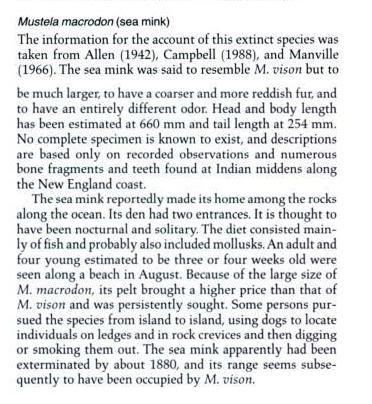|
|
Post by Bhagatí on May 5, 2008 19:22:16 GMT
|
|
|
|
Post by another specialist on May 6, 2008 6:49:27 GMT
Skeleton of Extinct North American Sea Mink (Mustela macrodon) Authors: Mead J.I.1, 2; Spiess A.E.3; Sobolik K.D.4 Source: Quaternary Research, Volume 53, Number 2, March 2000 , pp. 247-262(16) Publisher: Academic Press Abstract: Mustela macrodon (extinct sea mink) is known only from prehistoric and historic Native American shell middens dating less than 5100 years old along coastal islands of the Gulf of Maine, northeastern North America. The species is distinct from all known extant subspecies of M. vison (American mink) but still belongs to the North American subgenus Vison. Metric comparisons between M. macrodon and five subspecies of M. vison, using skull, mandible, humerus, radius, femur, and tibia skeletal elements, show that M. macrodon is larger in overall size and robustness and is proportionately larger in the dental region. Many habitat-related parallels exist between coastal island mink of the Gulf of Maine and those of the Alexander Archipelago, southeastern Alaska, where the overall largest living subspecies of mink is found (M. v. nesolestes). Copyright 2000 University of Washington. www.ingentaconnect.com/content/ap/qr/2000/00000053/00000002/art02109Could be interesting but it an't free shame |
|
|
|
Post by another specialist on May 6, 2008 7:22:02 GMT
|
|
|
|
Post by Peter on May 24, 2008 14:54:51 GMT
Baghira, that is fantastic image of the sea mink. One I didn't have seen before. I think the best available right now. And I see I haven't posted my seamink image yet, so here it is:  Created by Peter Maas for The Extinction Website. This image has been released under the Creative Commons Attribution Non-commercial No Derivatives 3.0 Licence. Source: www.petermaas.nl/extinct/speciesinfo/seamink.htm. |
|
|
|
Post by Peter on May 24, 2008 14:57:23 GMT
An image with its previous range:  Image: a range map showing the possible previous distribution of the Sea Mink in North America (in red). Created by Peter Maas for The Extinction Website. This image has been released under the Creative Commons Attribution Non-commercial No Derivatives 3.0 Licence. Source: www.petermaas.nl/extinct/speciesinfo/seamink.htm. |
|
|
|
Post by another specialist on May 28, 2008 15:11:13 GMT
|
|
|
|
Post by another specialist on Jul 13, 2008 18:21:07 GMT
PECIES Neovison macrodon Author: Prentis, 1903. Citation: Pro. U.S. Natl. Mus., 26: 887. Common Name: Sea mink Type Locality: "Brooklin, Handcock County, Maine." [Brooklin archaeological site on Black Isl, Maine]. Distribution: Formerly found along the coasts of Canada (New Brunswick) and USA (Maine). Status: IUCN – Extinct as Mustela macrodon. Comments: Last collected in 1894. Manville (1966) argued that recently extinct form macrodon is conspecific with vison, although Kurtén and Anderson (1980) and Mead et al. (2000) recognized it as a distinct species. www.bucknell.edu/msw3/browse.asp?s=y&id=14001483 |
|
|
|
Post by another specialist on Aug 8, 2008 17:58:57 GMT
 Walker's Mammals of the World By Ronald M. Nowak, Ernest Pillsbury Walker |
|
|
|
Post by Bhagatí on Aug 17, 2010 10:41:27 GMT
|
|
|
|
Post by Peter on Aug 18, 2010 10:29:25 GMT
Hi baghira, This is not a Sea Mink, as they became extinct in 1860 or 1894. At that time they could not make photographed like this one. It is probably another species of marten/mink/ferret. One that is nowadays kept in fur farms.  |
|
|
|
Post by another specialist on Aug 18, 2010 21:41:38 GMT
to me it's a standard mink not a sea mink.
|
|
Deleted
Deleted Member
Posts: 0
|
Post by Deleted on Aug 19, 2010 10:29:03 GMT
By the way, this is clearly an Sea Otter ( Enhydra lutris).: |
|
|
|
Post by Peter on Aug 19, 2010 20:18:35 GMT
|
|
|
|
Post by Bhagatí on Aug 23, 2010 5:11:28 GMT
Thanks! I'm used the wrong image of this species! After this link: candobetter.org/node/746is lie! But it I'm don't known! Sorry! |
|
|
|
Post by Bhagatí on Dec 15, 2012 15:44:13 GMT
|
|
|
|
Post by koeiyabe on Nov 28, 2015 18:56:41 GMT
 "Living Things Vanished from the Earth (in Japanese)" by Toshio Inomata (1993) with Dawson's Caribou, Xerces Blue, and general wolf. |
|
|
|
Post by surroundx on Jan 17, 2016 13:13:38 GMT
|
|
|
|
Post by Melanie on Jul 17, 2016 22:08:18 GMT
|
|
|
|
Post by Melanie on Jul 17, 2016 22:18:12 GMT
|
|
|
|
Post by surroundx on Apr 21, 2017 14:35:14 GMT
|
|